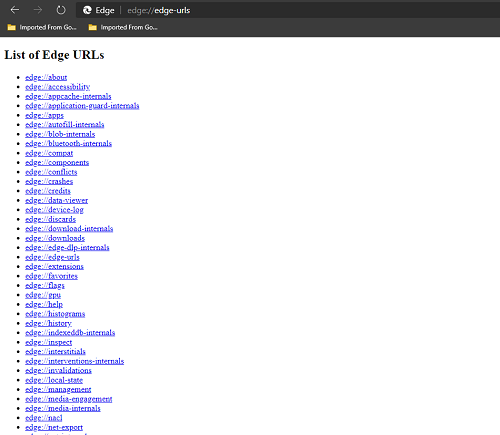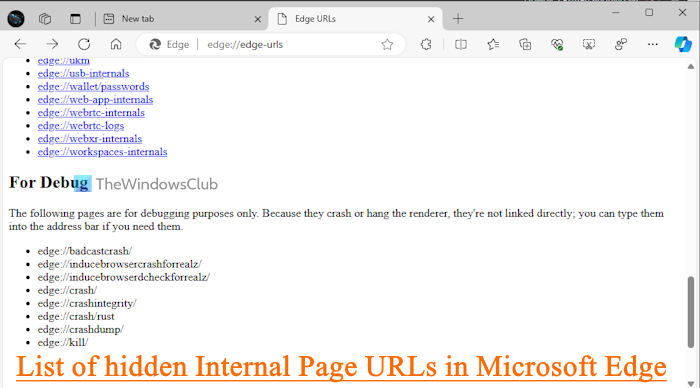Just like Google Chrome and other Chromium-based browsers, Microsoft Edge also includes a list of internal web pages that provide extra details about various browser features. In this article, we will cover the list of all hidden Internal Page URLs’ (or Edge URLs) in Microsoft Edge on Windows 11/10.
Microsoft Edge is currently the rising star of Microsoft. If you are already using this Chromium-based browser then you might know that with newly added features – the browser is more friendly in every aspect. The browser ships with various supports like AAD, 4K streaming, Dolby audio, PDF inking, Bing integration, support for Chrome-based extensions, etc. Now let’s check the list of Edge URLs to get more benefits using it.
Internal Page URLs in Microsoft Edge
As most browser makers change the protocol of internal pages, Microsoft Edge is also now one of those. To access the internal pages, type edge:// followed by a resource in the address bar.

To access the list of all internal pages of Edge browser, type the following text in the address bar or Omnibox, and hit Enter:
edge://edge-urls/
It will display a list of all resources currently available in the browser. Now, these hidden capabilities are not only developer-centric but also common user-friendly.
List of Edge URLs
- edge://about
- edge://accessibility
- edge://app-service-internals
- edge://app-settings
- edge://application-guard-internals
- edge://apps
- edge://attribution-internals
- edge://augloop-internals
- edge://bluetooth-internals
- edge://compat
- edge://components
- edge://conflicts
- edge://crashes
- edge://credits
- edge://data-viewer
- edge://device-log
- edge://discards
- edge://download-internals
- edge://downloads
- edge://edge-dlp-internals
- edge://edge-urls
- edge://extensions
- edge://favorites
- edge://flags
- edge://gpu
- edge://help
- edge://histograms
- edge://history
- edge://indexeddb-internals
- edge://inspect
- edge://interstitials
- edge://interventions-internals
- edge://invalidations
- edge://local-state
- edge://management
- edge://media-engagement
- edge://media-internals
- edge://nacl
- edge://net-export
- edge://net-internals
- edge://network-error
- edge://network-errors
- edge://new-tab-page
- edge://newtab
- edge://ntp-tiles-internals
- edge://omnibox
- edge://password-manager-internals
- edge://policy
- edge://predictors
- edge://prefs-internals
- edge://print
- edge://process-internals
- edge://push-internals
- edge://quota-internals
- edge://sandbox
- edge://serviceworker-internals
- edge://settings
- edge://signin-internals
- edge://site-engagement
- edge://supervised-user-internals
- edge://sync-internals
- edge://system
- edge://terms
- edge://tracing
- edge://translate-internals
- edge://usb-internals
- edge://user-actions
- edge://version
- edge://webrtc-internals
- edge://webrtc-logs
For Debug

The following pages are for debugging purposes only. Because they crash or hang the renderer, they’re not linked directly; you can type them into the address bar if you need them.
- edge://badcastcrash/
- edge://inducebrowsercrashforrealz/
- edge://inducebrowserdcheckforrealz/
- edge://crash/
- edge://crashintegrity/
- edge://crash/rust
- edge://crashdump/
- edge://kill/
- edge://hang/
- edge://shorthang/
- edge://gpuclean/
- edge://gpucrash/
- edge://gpuhang/
- edge://memory-exhaust/
- edge://memory-pressure-critical/
- edge://memory-pressure-moderate/
- edge://inducebrowserheapcorruption/
- edge://crash/cfg
- edge://heapcorruptioncrash/
- edge://quit/
- edge://restart/
We are covering below a few of the useful ones that are available in Microsoft Stable. Development versions of the browser may include additional resources.
edge://apps
Check all the applications you have downloaded and installed in the browser. It is quite useful to navigate directly to the applications page rather than clicking here and there your way around from the default homepage. Also, you can access the Microsoft Edge Add-ons to download and install additional apps, extensions, themes, etc.
edge://accessibility
Use this page to inspect the internal representation of accessibility in Edge. See and modify the various accessibility modes the browser has. You can also view the accessibility tree for a specific page, or the browser application natively.
edge://components
Here you can get the list of all the components your browser is using while browsing the web, just as Adobe Flash Player, Widevine Content Decryption Module, Trust Protection Lists, and other components.
edge://crashes
This particular page shows a list of recent crashes that your Edge browser may have experienced over time. To check the no. of crashes, enable crash reporting.
edge://download-internals
You can use this page to see the list of all previous completed/failed, in-progress downloads along with their download information. It also allows you to download something just by entering the URL of the file.
edge://downloads
This will open up the browser’s native Download Manager page where you can see all your past downloads. Pretty fast way to navigate to your downloads than finding your way around the hamburger menu!
edge://extensions
Using this URL you can check all the extensions installed on your Edge browser. Check all the extension settings, add or remove extensions, enable/disable developer mode, etc.
edge://favorites
As the URL indicates, it opens the Favorites page of Microsoft Edge where you can see a list of all saved bookmarks present in the Favorites bar, Other favorites, etc.
edge://history
For developers and computer enthusiasts “Ctrl+H” is still the most preferred shortcut. This URL takes you to the recent browsing history where you can clear it or look for a webpage that you visited in the past.
edge://newtab
Just like the URL above, some of us will still prefer “Ctrl+T”. Enter the URL in the address bar, press Enter and a new browsing tab will open up.
edge://predictors
This URL displays a list of Autocomplete Action Predictors and Resource Prefetch Predictors based on your recent search and browsing history.
edge://print
This URL opens up the print dialog box where you can save a webpage as a PDF file or you can send your file to any printer connected to your current network. It works the same way the keyboard shortcut “Ctrl+P” does.
edge://settings
As the URL says, you can visit the Settings page of the browser using this URL. Change the behavior, appearance, etc and make the browser work according to you.
edge://terms
You can take a look at Microsoft Software License Terms on this URL. According to Microsoft, “These license terms are an agreement between you and Microsoft Corporation (or one of its affiliates). They apply to this software published by Microsoft and any software updates (“Software”) (except to the extent such Software or updates are accompanied by new or additional terms, in which case those different terms apply prospectively and do not alter your or Microsoft’s rights relating to pre-updated Software).”
edge://version
Use this URL when you want to take a look at the current version of your Edge browser with some additional information regarding JavaScript, Flash version, and other relevant details.
These are some of the internal URLs’ you can use if you can’t find your way in the browser. Sometimes it does happen that you go on clicking here and there to find some settings and end up closing the browser.
edge://sandbox
This URL shows the sandbox status of different processes. You can see the Process ID, sandbox status (sandboxed or not), process type (GPU, Renderer, or Utility), Lockdown type (Restricted Non-Admin, Lockdown, or Limited), Integrity type, etc.
Go on and try the other URL’s in the list. Let us know which of these URLs are new and useful for you in the comments section below.
Now read: How to access and use Microsoft Edge about:flags page on Windows PC
Does Microsoft Edge have private browsing?
Yes, just like Google Chrome has an Incognito mode feature, Firefox has a Private window feature, the Microsoft Edge browser also comes with a private browsing feature called InPrivate window. You can access the Settings and more (Alt+F4) menu of the Edge browser and click on the New InPrivate window option to open the private browsing session. Alternatively, you can press the Ctrl+Shift+N hotkey to start browsing in private mode.
How do you unblock a URL in Edge?
If you have blocked a website or URL in Edge using an extension, then use the same extension to unblock it. You need to access the Settings or blocked websites list page of that extension and delete the URL from there. You can also temporarily disable that extension or uninstall it. On the other hand, if a website is blocked using a Hosts file, then open that file in Notepad, delete the URL and related line from that file, and save the Hosts file.
Read next: How to disable about:flags page in Microsoft Edge browser.
Leave a Reply